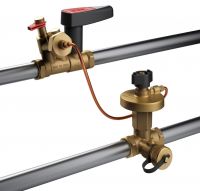Hello,
I have a problem with a new Purmo radiator with Danfoss 013G5164 thermostatic kit installed. I live in a block of flats on the ground floor.
A few days ago, the heater only warmed up in the top half, the bottom half was cold. It was probably due to the closed return valve. I unscrewed the valve, unfortunately now the radiator does not heat up at all. When I unscrew the vent, the glycol flows from the radiator, it does not foam, it does not hiss, so the radiator is deaerated. I took off the thermostatic head and tried to adjust the RA-N thermostatic valve to open it as much as possible. It did not help, however. The heater is still cold.
I would like to add that I have built the pipes of the riser behind the GK. I can only touch the piece of pipe which is horizontally off the vertical and to which the radiator is screwed. This morning it was slightly warm, now it is cold. The cooperative says everything is fine with the outside plumbing and riser. In other rooms, the radiators heat up properly and heat up in about 2 minutes.
Please help. I already lack ideas to solve the problem.
I have a problem with a new Purmo radiator with Danfoss 013G5164 thermostatic kit installed. I live in a block of flats on the ground floor.
A few days ago, the heater only warmed up in the top half, the bottom half was cold. It was probably due to the closed return valve. I unscrewed the valve, unfortunately now the radiator does not heat up at all. When I unscrew the vent, the glycol flows from the radiator, it does not foam, it does not hiss, so the radiator is deaerated. I took off the thermostatic head and tried to adjust the RA-N thermostatic valve to open it as much as possible. It did not help, however. The heater is still cold.
I would like to add that I have built the pipes of the riser behind the GK. I can only touch the piece of pipe which is horizontally off the vertical and to which the radiator is screwed. This morning it was slightly warm, now it is cold. The cooperative says everything is fine with the outside plumbing and riser. In other rooms, the radiators heat up properly and heat up in about 2 minutes.
Please help. I already lack ideas to solve the problem.



